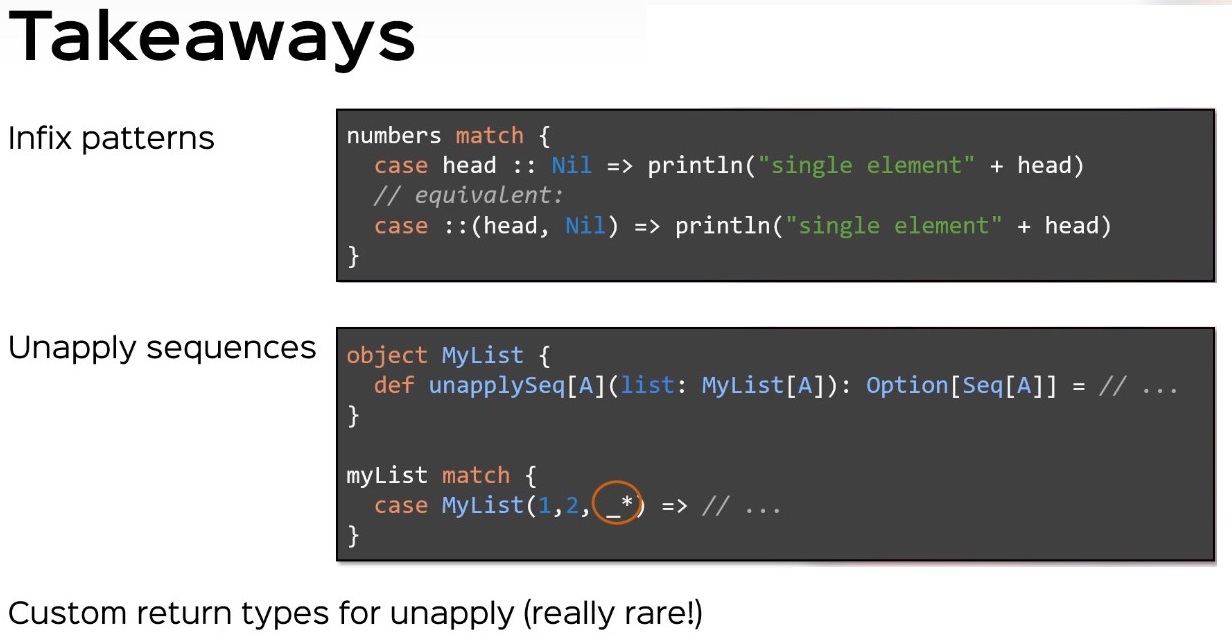ScalaSchool
Pattern matching
Pattern matching is used for decomposing data structures:
unknownObject match {
case MyClass(n) => ...
case MyClass2(a, b) => ...
}
Here are a few example patterns
(someList: List[T]) match {
case Nil => ... // empty list
case x :: Nil => ... // list with only one element
case List(x) => ... // same as above
case x :: xs => ... // a list with at least one element. x is bound to the head,
// xs to the tail. xs could be Nil or some other list.
case 1 :: 2 :: cs => ... // lists that starts with 1 and then 2
case (x, y) :: ps => ... // a list where the head element is a pair
case _ => ... // default case if none of the above matches
}
The last example shows that every pattern consists of sub-patterns: it
only matches lists with at least one element, where that element is a
pair. x and y are again patterns that could match only specific
types.
Options
Pattern matching can also be used for Option values. Some
functions (like Map.get) return a value of type Option[T] which
is either a value of type Some[T] or the value None:
val myMap = Map("a" -> 42, "b" -> 43)
def getMapValue(s: String): String = {
myMap get s match {
case Some(nb) => "Value found: " + nb
case None => "No value found"
}
}
getMapValue("a") // "Value found: 42"
getMapValue("c") // "No value found"
Most of the times when you write a pattern match on an option value,
the same expression can be written more concisely using combinator
methods of the Option class. For example, the function getMapValue
can be written as follows:
def getMapValue(s: String): String =
myMap.get(s).map("Value found: " + _).getOrElse("No value found")
Pattern Matching in Anonymous Functions
Pattern matches are also used quite often in anonymous functions:
val pairs: List[(Char, Int)] = ('a', 2) :: ('b', 3) :: Nil
val chars: List[Char] = pairs.map(p => p match {
case (ch, num) => ch
})
Instead of p => p match { case ... }, you can simply write {case ...}, so the above example becomes more concise:
val chars: List[Char] = pairs map {
case (ch, num) => ch
}

How does it all work?
Behind the scenes the Scala compiler looks for a special method called unapply to see if a match can be found.
If the unapply method returns an Option[T] you have an extractor
class Person(val name: String, val age: Int)
object Person {
def unapply(person: Person): Option[(String, Int)] = Option(person).map{p => (p.name, p.age)}
}
val bob = new Person("Bob", 25)
val greeting = bob match {
case Person(n, a) => s"Hi, my name is $n and I'm $a years old."
}
"Hi, my name is Bob and I'm 25 years old" is printed
Here in the pattern match above, the compiler sees there exists a method called unapply in the Person object, that takes a person intance and optionally returns a tuple
of (Int, String). Person.unapply(bob) = Some(“Bob”, 25). Since the Option is not empty the “pattern” is matched. And n is given the value “Bob” and a is given the value 25.
If the unapply method returns an Boolean, then your unapply just tests true vs false
class Person(val name: String, val age: Int)
object Person {
def unapply(person: Person): Option[(String, Int)] = Option(person).map{p => (p.name, p.age)}
}
object LegalPerson {
def unapply(person: Person): Boolean = person.age > 21
}
val bob = new Person("Bob", 25)
val greeting = bob match {
case LegalPerson() => "They are legal"
case Person(n, a) => s"Hi, my name is $n and I'm $a years old."
}
"They are legal" is printed
Here in the pattern match above, the compiler sees there exists a method called unapply in the LegalPerson object, that takes a person intance and returns boolean. LegalPerson.unapply(bob) = True. Since the boolean is true the “pattern” is matched.
But actually you can destructure (i.e. pattern) match via an object that has a get() and isEmpty() method
abstract class Wrapper[T] {
def isEmpty: Boolean
def get: T
}
class Person(val name: String, val age: Int)
object PeronWrapper {
def unapply(person: Person): Wrapper[String] = new Wrapper[String] {
def isEmpty = false
def get: String = person.name
}
}
val bob = new Person("Bob", age = 51)
val whatHappened: String = bob match {
case PeronWrapper(n) => s"wow $n it worked!"
}
